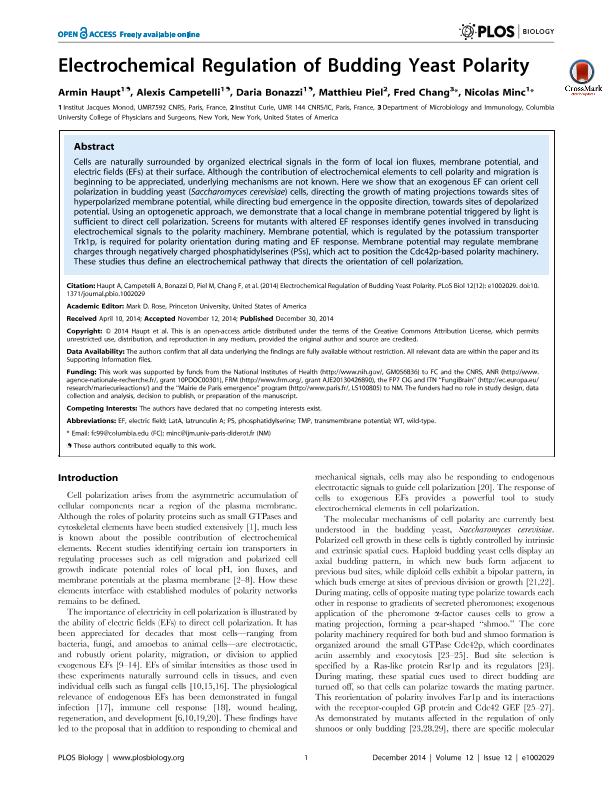Mostrar el registro sencillo del ítem
dc.contributor.author
Haupt, Armin
dc.contributor.author
Campetelli, Alexis Nazareno

dc.contributor.author
Bonazzi, Daria
dc.contributor.author
Piel, Matthieu
dc.contributor.author
Chang, Fred
dc.contributor.author
Minc, Nicolas
dc.date.available
2018-01-24T17:39:32Z
dc.date.issued
2014-12
dc.identifier.citation
Haupt, Armin; Campetelli, Alexis Nazareno; Bonazzi, Daria; Piel, Matthieu; Chang, Fred ; et al.; Electrochemical Regulation of Budding Yeast Polarity; Public Library of Science; Plos Biology; 12; 12; 12-2014; 1-13; e1002029
dc.identifier.issn
1544-9173
dc.identifier.uri
http://hdl.handle.net/11336/34417
dc.description.abstract
Cells are naturally surrounded by organized electrical signals in the form of local ion fluxes, membrane potential, and electric fields (EFs) at their surface. Although the contribution of electrochemical elements to cell polarity and migration is beginning to be appreciated, underlying mechanisms are not known. Here we show that an exogenous EF can orient cell polarization in budding yeast (Saccharomyces cerevisiae) cells, directing the growth of mating projections towards sites of hyperpolarized membrane potential, while directing bud emergence in the opposite direction, towards sites of depolarized potential. Using an optogenetic approach, we demonstrate that a local change in membrane potential triggered by light is sufficient to direct cell polarization. Screens for mutants with altered EF responses identify genes involved in transducing electrochemical signals to the polarity machinery. Membrane potential, which is regulated by the potassium transporter Trk1p, is required for polarity orientation during mating and EF response. Membrane potential may regulate membrane charges through negatively charged phosphatidylserines (PSs), which act to position the Cdc42p-based polarity machinery. These studies thus define an electrochemical pathway that directs the orientation of cell polarization.
dc.format
application/pdf
dc.language.iso
eng
dc.publisher
Public Library of Science

dc.rights
info:eu-repo/semantics/openAccess
dc.rights.uri
https://creativecommons.org/licenses/by-nc-sa/2.5/ar/
dc.subject
Electrochemistry
dc.subject
Cell Polarity
dc.subject
Yeast
dc.subject
S. Cerevisiae
dc.subject.classification
Otras Ciencias Biológicas

dc.subject.classification
Ciencias Biológicas

dc.subject.classification
CIENCIAS NATURALES Y EXACTAS

dc.title
Electrochemical Regulation of Budding Yeast Polarity
dc.type
info:eu-repo/semantics/article
dc.type
info:ar-repo/semantics/artículo
dc.type
info:eu-repo/semantics/publishedVersion
dc.date.updated
2018-01-24T14:41:39Z
dc.journal.volume
12
dc.journal.number
12
dc.journal.pagination
1-13; e1002029
dc.journal.pais
Estados Unidos

dc.journal.ciudad
San Francisco
dc.description.fil
Fil: Haupt, Armin. Institut Jacques Monod; Francia
dc.description.fil
Fil: Campetelli, Alexis Nazareno. Institut Jacques Monod; Francia. Consejo Nacional de Investigaciones Científicas y Técnicas; Argentina
dc.description.fil
Fil: Bonazzi, Daria. Institut Jacques Monod; Francia
dc.description.fil
Fil: Piel, Matthieu. Institute Curie; Francia
dc.description.fil
Fil: Chang, Fred. Columbia University; Estados Unidos
dc.description.fil
Fil: Minc, Nicolas. Institut Jacques Monod; Francia
dc.journal.title
Plos Biology

dc.relation.alternativeid
info:eu-repo/semantics/altIdentifier/doi/http://dx.doi.org/10.1371/journal.pbio.1002029
dc.relation.alternativeid
info:eu-repo/semantics/altIdentifier/url/http://journals.plos.org/plosbiology/article?id=10.1371/journal.pbio.1002029
Archivos asociados
